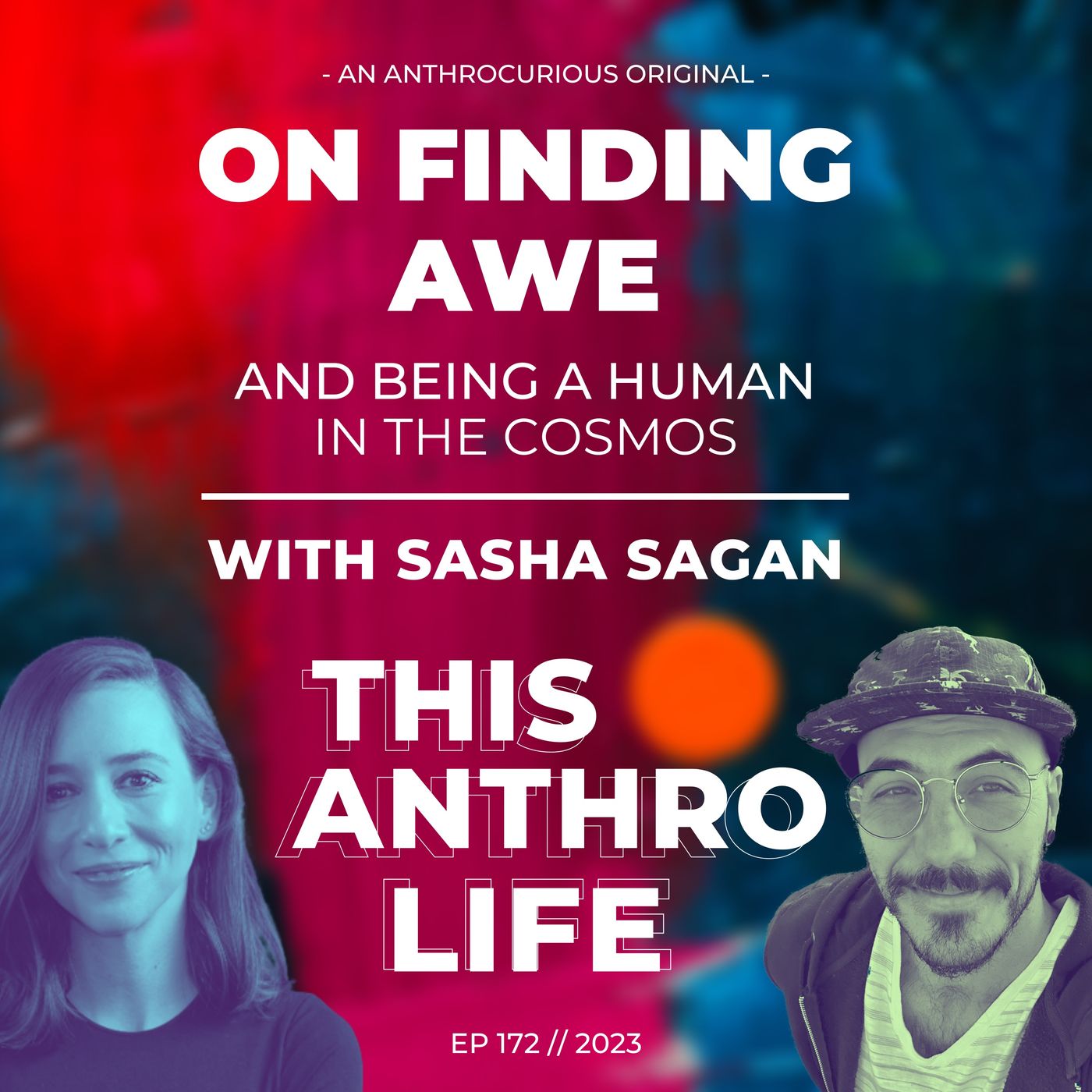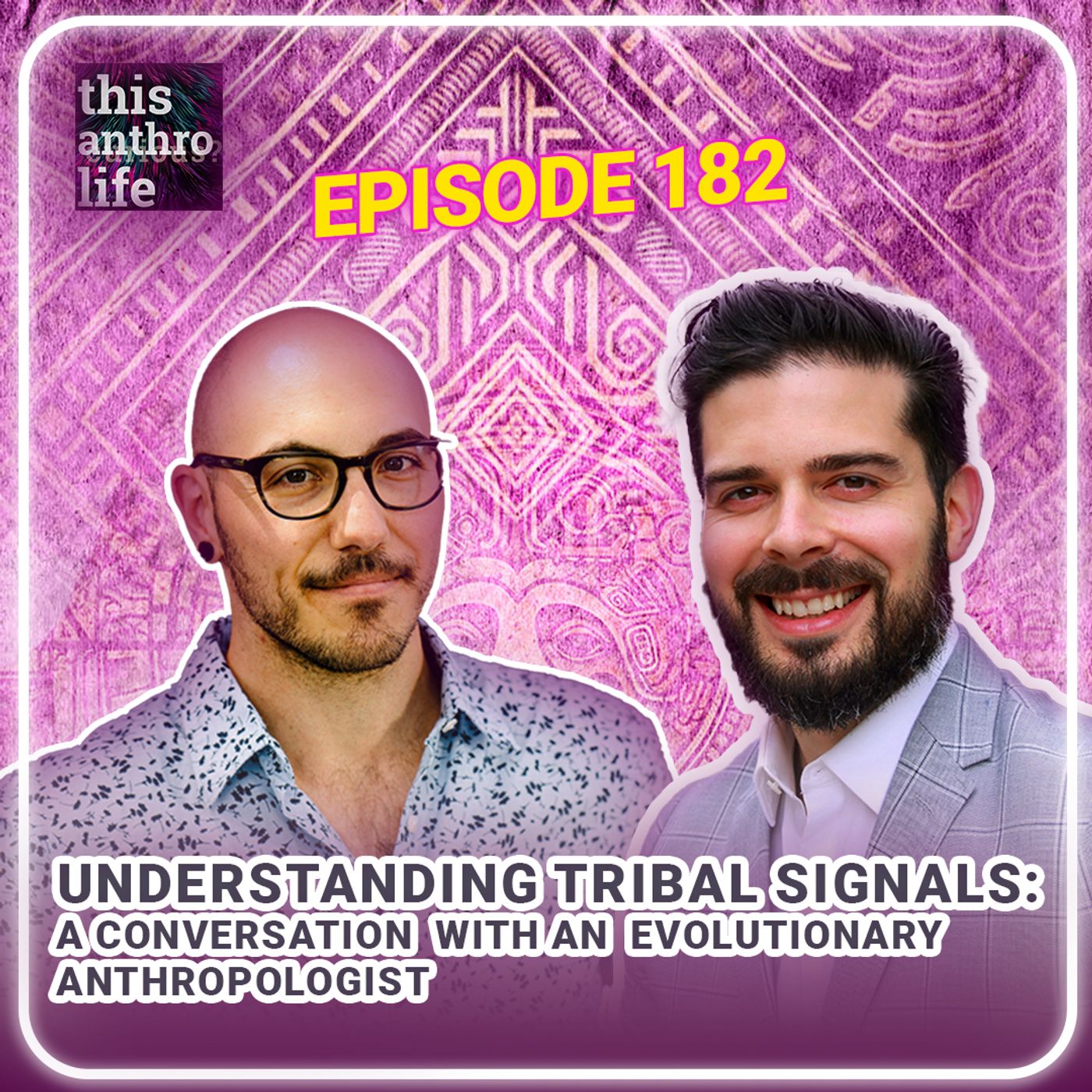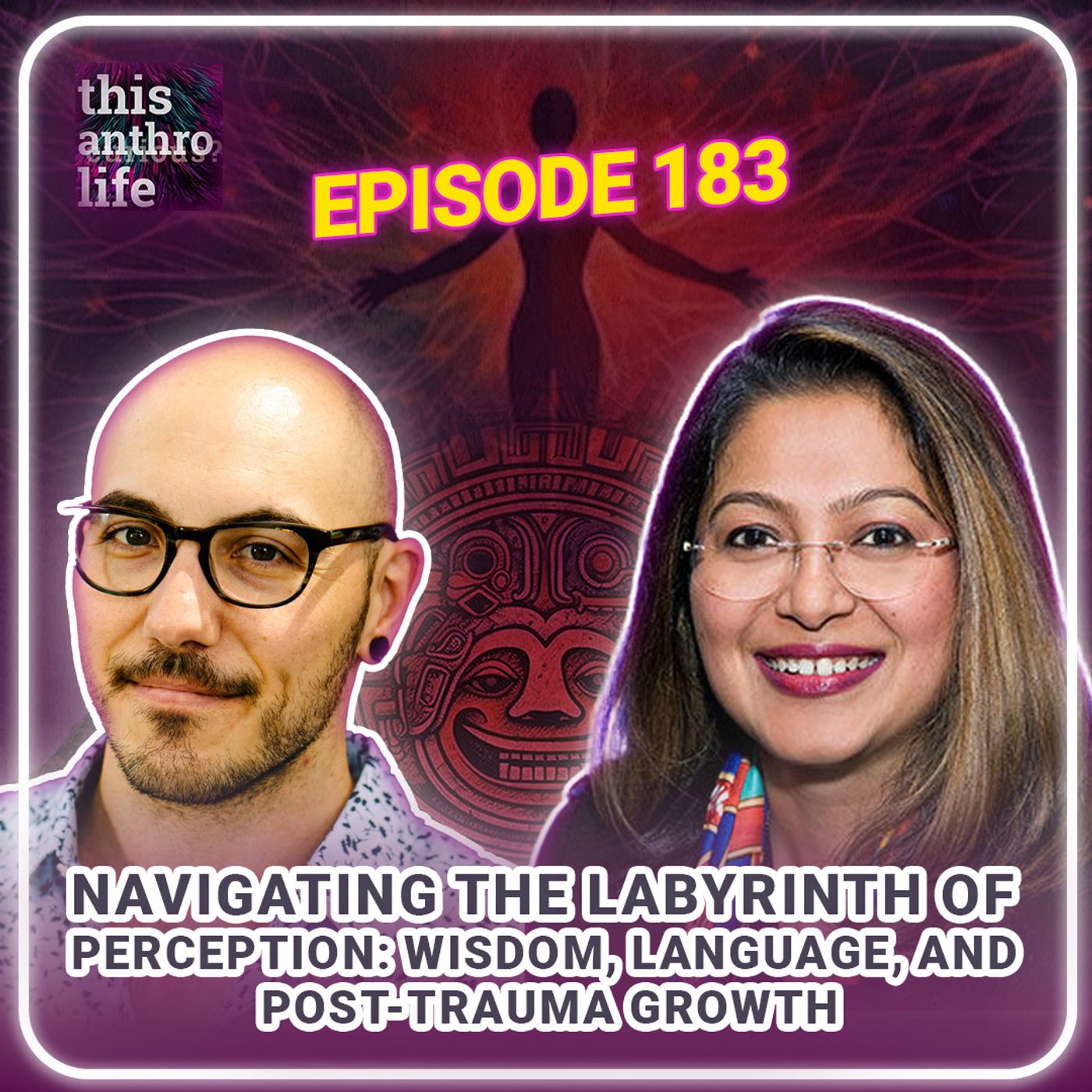Mate: The Drink Beyond a Drink w/ Guilherme Heiden


Mate (pronounced mah-tay), or more commonly known as yerba mate for English speakers, is an herbal tea drink native to parts of South America – Southern Brazil, Argentina, Uruguay, and Paraguay – where local people drank it for thousands of years. The...
Many see this drink as beyond a drink – aside from its colorful and unique drinking apparatus made from a dried-out gourd and metal straw. Mate is known to break down barriers between people of different groups, classes, ethnicity, even religions (trust us, you’ll learn about this one).
Join Adam and special guest Guilherme Heiden, a Southern Brazilian mate enthusiast and expert, coming to you live from fieldwork in Peru, as they explore the fascinating, and thirst-quenching world of mate.
[00:00:00] Adam Gamwell: Hey, everybody. This is Adam Gamwell here for This Anthropological Life coming to you from Peru. You may have noticed that was a strange noise that we just heard. But today, we're talking about mate, the tea. And so, this is, you know, you may hear some interesting sound effects during today's show. I've been hoping for a while to be able to do some episodes here in Peru in the field. But as you can imagine, it's really quite busy. And so, as luck would have it, I've been working with a friend of mine for the past month and a half on a separate project regarding quinoa conservation. More on that for another episode. But for now, so my friend is Guilherme Heiden. He's an agricultural engineering student from Rio Grande do Sul in Southern Brazil. One of the things that he brought with him and brought into my life is the culture of drinking mate. Subsequently after we met, I also found out that he's the head of the Circle of Drink - Brazil, which is the world's largest online mate drinking community, which is pretty cool. And after a month and a half of working with Guilherme, I can say that I too am hooked on mate. So, one of the fun parts about this episode today is that, you know, I'm a US citizen. He's a Brazilian citizen. We're working together in Peru and we're talking about mate. Now, you know, on TAL, we've done episodes before on coffee, on beer, amongst other foods. So, I thought this would be a great continuation of our exploration of food and drink cultures on This Anthropological Life. Now, briefly, mate is tea. In regions where it's drunk, which now is all around the world, you know, we're getting some of the history predominantly in regions of Brazil, Uruguay, Paraguay, Argentina. Mate is culturally significant. It's as culturally significant as black tea is to Scotland or as coffee is to Italians or as wine is to France or you might also say as beer is to the United States people. It's not just a beverage. Really mate is this social and cultural unifier. It's this identifier that can move across national, cross linguistic borders and create something that we wanna explore today called the culture of mate or what is that. So, Guilherme, thank you so much for joining me today for a conversation. I'm really excited to be here. And so, why don't we get started first by you telling us a bit about yourself?
[00:02:21] Guilherme Heiden: Well, I have to say that I'm thrilled by that. But, well. Hello, everybody. Great to be here sharing a bit of my story and my culture with you, the Gauchos culture. First of all, of course, special hello to my Brazilian friends, to my university, my fellows from Federal University of Pelotas, to my people in the Circle of Drink. As Adam has already mentioned, the biggest mate circle in the world, brought to us by Dave Mate, who loves mate just like me and now just like us. And, well, it is a pleasure to be here talking and also drinking mate with you during this conversation. And I have to say that I really loved your first podcast about the World Cup in Brazil, so that made me really excited to be here, sharing a bit more about my country. And, you know, getting to exploit it through your interesting anthropological viewpoint of the world. So, thanks, Adam, for having me here. It's great.
[00:03:18] Adam Gamwell: Thank you. That's really nice of you to say. Why don't we dive in a bit more. Tell me a bit more. How did you learn English? You know, you're from Southern Brazil. Here we are in Peru, speaking on an English podcast.
[00:03:29] Guilherme Heiden: Yeah. You know, that's crazy. Well, I have to say that I learned English back in 2013 when I received a scholarship from the Brazilian government through the Science without Borders program. And through that, I went to study in Budapest, Hungary, even though the first language in Hungary is Hungarian. I had really good English lessons with Hungarian teachers and Europeans, in general. And I ended up somehow learning English like many other Brazilians and some of whom are still, I have to say that they are still active in the Science without Borders web community. And what is really cool to me that they, this program had has had such a positive impact that many of us are still involved in the community, helping others to have the same opportunity, develop us, and, you know, trying to make all of us to speak English. So, you know, that's crazy, but that's the way.
[00:04:23] Adam Gamwell: That's the way of the world over there, isn't it? That's really cool. I think it, that's one of the things I'm excited about to talk today is that mate itself is sort of this emblem of globalization in one way and the different cultures coming together and how they mix in unique ways. And so, I thought we could kick things off by, you know, telling us a bit about who originally drank mate.
[00:04:45] Guilherme Heiden: Yeah. Well, originally, who drank mate were the indigenous tribes from South America. But I have to tell you that I prefer, I like to say the gauchos. I mean the, in a short way, I have to say, now, I have to explain the gauchos, you know? It's not fair. In short, we say we may say that the Gaucho culture is the result of a mix between different ethnic groups who impacted the Pampas or grassland or our local landscape. And the first I think group are, of course, the indigenous populations who first lived there and later on, the Europeans who ended up in I would say in the southernmost part of Brazil and in South America itself to colonize it. And some years later, people of African descent came from other regions of the Brazil colony and got together with the Europeans and the local indigenous to give birth to the gauchos, who still inhabit our lands. So, back then around let me say 1680, life in the fields is characterized by grazing cattle and a nomadic lifestyle around the borders of Southern Brazil, Argentina, Paraguay, Uruguay, more or less with a life based on the livestock. Later on, of course, with establishment of the livestock farms, huge extensions of land were the farms and the first cities. Were the first the farms were the first cities in the region with these guys, the gauchos. So, the mixture of the indigenous, the Portuguese, the Spaniards and the African descents — these are the first guys who drank mate. And, of course, with lots of traces from the Guarani and the Charrúa tribes. So, who had always drink mate. And, you know, the Jesuits missionaries, they spread the popularity of drinking mate.
[00:06:44] Adam Gamwell: Yeah, that's a really an interesting story. It is one of the things that when we dive into to think about mate and sort of the cultural story of it, really how much of this history is not known to the rest of the world. But it's such a fascinating connection between, as you said, Europeans, indigenous tribes, Africans, and you really, the, you know, the whole world on one level. There's a little microcosm of different groups coming together. What's interesting, too, is that today in these countries, as you mentioned, Brazil, in Argentina, Uruguay, Paraguay, mate has really become this national identity or part of national identity in that to be any one of these citizens, which is incredible in four countries, is to drink mate. To be a citizen is to drink mate. What's interesting is that I looked at this piece, it was by ReVista in Harvard University in the United States, about the many meanings of yerba mate. And one of the respondents within this article, his name is Gustavo Fischman, and he pointed out that because yerba mate on some level has been nationalized and very few people make this direct connection that really we're drinking something with indigenous roots. And when I read this, it got me really thinking. And as you shared, as you shared your story, too, that even the gauchos and this, there's this connection, there's this mixture between indigeneity, between traveling, you know, colonial missionaries, and then just local cultures and this really interesting mix. And so, as we dive into this, we see that when we even say the word "mate," what are we talking about, right? And when you and I say "mate," it actually comes from the Kichwa word and Kichwa is in the linguistic family of Quechua where we are, we're working in southern Peru these days, and Quechua is spoken here along with another language called Aymara. And then the linguistic family of Quechua and Kichwa spreads up into Ecuador, into parts of Columbia and Chile, over into Argentina and parts of Brazil, too. So, it really is this large linguistic family. But so, we're saying Kichwa or mate, which is interesting. And that's sort of what the Jesuit priests picked up on and then ended up calling it. And then, mate is just this Kichwa for plant shell. It's describing the shell of a plant, in essence. In Guarani, the group you mentioned, too, it's called ka'a and that just means plant in general. And so, it's interesting to think even in terms of linguistically where we see the idea of what mate is. Now, as you said, too, we know that mate was probably first cultivated by the Guarani Indians. And so with that, we know that it was drank for mystical rituals. It was used as a welcoming drink, which is one of the, which is interesting 'cause that's one of the hallmarks that we still see today. But I mean, that's that is one of the main things that we'll dive into that we see that mate is about as well as they drank it for energizing properties. And as we know, and if anybody has tried mate or drank it before, you'll know, too, that it has really nice energizing property. It has some caffeine and some other antioxidants to boost your energy levels. Now, mate is such an important part to Guarani culture that they have a legend for about where it came from, which I think is really cool. And I wanna, you know, take a minute to share it with you. And so, it said in this legend that one day, an old nomad, an old nomad man was too weak to keep following his tribe. So, he decided to take a rest. He said, me and my daughter will take a rest here and let the tribe continue on. But they soon ran out of food. And so, one night, this stranger visited them and asked for food and for shelter. So, the old father and his daughter generously gave away whatever they had. They had just a little bit left. They gave what they had to the stranger. Now, he was surprised by such hospitality, this visitor who was actually Tupã, the Guarani supreme god, which is always awesome to be visited by the supreme god. He was surprised by their hospitality, so he offered them a plant that he created to make a special kind of tea, you know, so they would never be thirsty. They'd always remain healthy. This is where we got mate, it's said. And so, he also told them to share this beverage with others from the tribe. And so, in this way we can see that mate has become synonymous with the idea of sharing with health amongst friends and notions of endurance, too, that we can carry on and be healthy, which is a nice legend I think. And then as you pointed out, too, Guil, which is helpful as a thing is that then the habit of drinking mate itself spread throughout South America first by Jesuit missionaries. They're the ones that picked up on it and then started bringing it to other missions, to other churches. And then later on by cowboys, known as the gauchos, right?
[00:11:18] Guilherme Heiden: Yeah.
[00:11:19] Adam Gamwell: Kinda moving with that, what's really interesting to me, too, in this story is that, you know, we have this, I think Guarani legend of where mate came from and then why we see the Jesuits spreading it. And so, what's interesting is that there's this research from a Brazilian anthropologist who I'm gonna, you know, say his name poorly 'cause I can't speak Portuguese, but he's — I think something like that. But he's conducted research amongst the Guarani. And so, drawing on this research, there's an author named Richard Kane who made this really interesting argument that we actually see the prototypes for institutions like communism and capitalism developed in the relationship between Jesuits and Guranai through the mixing of creating plantations for production of mate really through indentured servitude. And it's this, you know, it's the similar story that we do see in a lot of colonial stories, which is sad that, you know, the missionaries came over, the colonials came over to different parts of North and South America and put the indigenous people to indentured servitude or slavery usually in terrible conditions. But yet so what we're seeing with this is the idea that there was this was the first time that we saw creation of the of plantations of yerba mate in this case and they're called yerbales. And these basically just are, you know, giant plantations in which they were, you know, created these massive extensions of mate. Interestingly 'cause, you know, you pointed out before the idea that the gauchos also today work on massive plantations also. And so, these in some ways might be connected, you know, in a legacy of large extension farming in Southern Brazil in this case. What's really interesting, though, is that what happened to all these plantations specifically on yerba mate plantation amongst the Guaranis and Jesuits was where the first surplus of yerba mate was produced. But it was done in a way that the communities themselves were built around the socialist communist tradition of Karl Marx as well as there were the Jesuit superiors, his name was Superior General Father — a pretty solid name, superior general father. It's a nice honorific. But so, he was trying to create this sort of utopian idea of the communist society and he did it in this way that was through yerba mate plantations with indentured servitude, which doesn't to me sound terribly communist but an interesting experiment in history in this case. But what's interesting is also yerba mate ties us on some levels it seems into this idea that if we trace this production of yerba mate, we can see where it was used, he tried to originally use for international commerce to be sold in Europe and other places. It was used for industry. It was used in cases of war also. So, what really strikes me here is that basically if we trace the production of mate in this case to its roots, we also see in some level the roots of capitalism, the roots of communism, which you don't often, you know, think about together. And we see globalization, right? We see these many cultural traditions springing from this. And so, to me, it's just really a striking story, you know?
[00:14:21] Guilherme Heiden: Yeah. The Jesuits in South America, they had the misiones in my region in Portuguese, misiones in Spanish.
[00:14:31] Adam Gamwell: And the missions in English.
[00:14:33] Guilherme Heiden: Yeah. So, they had a very complex system of capitalism. And also, you know, I would say socialism. They tried to be, they were suspicious of trying to have an independent empire on the region. That's why they suffered like lots of battles, wars. And they try to, you know, to make them vanish. So, that is very interesting. But as we can see here, we had, as you probably have mentioned but as you have mentioned actually, we have this drink, which is a drink beyond the drink, you know? Which is a drink beyond the borders. I first said Uruguay, Paraguay, Argentina, Southern Brazil. But, you know, this is South America, so we have many words. We have mate, ka'a, cimarrón, you know? We have many different words. So, as I just mentioned, cimarrón is the Portuguese version of mate.
[00:15:32] Adam Gamwell: Cimarrón. Yeah.
[00:15:34] Guilherme Heiden: It's a hard word. And many guys for example, I would say, now I have to apologize for my French, but Saint-Exupéry, he's an, he's a guy, he's been in Rio Grande do Sul. He's been in South America in general, Southern Brazil, Brazil. And he wrote a, and he wrote his impressions about the gauchos, the culture of mate, the livestock culture and everything. He had a very, very good impression about the complex system that we had in the time back then. And when we talk about the missions, the misiones, there's an author from Rio Grande do Sul who wrote a book called Tiempo y Viento, which translated to English would be the time and the wind. And it's a very, it's a very cool title. So, this guy, he describes the whole complex relationship between the Guarani, the tribes, with the Jesuits. So, at the time, he had the, he wrote the, he writes about the family all along the centuries who had survived in Rio Grande do Sul and made his own empire and this kind of thing. And he writes a lot in his in the first version of the Tiempo y Viento, time and the wind, he writes a lot about the Spaniards and the Jesuits and the indigenous tribes, which is really interesting. I don't want to spoil the book here, so I hope you and our listeners will read that. So, the name is the Time and the Wind, but when we talk about the mate culture itself, we talk, it reminds me the contemporary culture mate with the, through the music, the poetry, the arts itself. I would say some very important writers and poets have always talked about mate. People not very well known, like Aureliano de Figueiredo Pinto, —, Jose Hernandez. These guys with their poems and writings, they had a whole mate literature, which is the Bible of, you know, of the gauchos. This is great. They're great. And, of course, some other poets and musicians like — from Rio Grande do Sul, Brazil, and Jose — from Argentia. They sang through their — and their songs a lot about mate as well. So, these guys, they let our minds fight through this beautiful mate and gaucho lifestyle, you know? So, as we already mentioned, this is the drink beyond the drink, you know, that's the, which this is a lifestyle without borders, you know?
[00:18:17] Adam Gamwell: Yeah. That's it's that's really cool. I mean, one thing that really strikes me about that, as you're saying, is that we see artists. We have, I mean, there's paintings, too, right? People have painting depictions. There's poetry. There's music. I mean, there's an entire, as you said, lifestyle. There's an entire, you know, artistic cultural tradition. Many of them really built around mate, you know? And so, I mean, I'm thinking here, it's like, what's your, what is it about mate, as you said, this drink beyond the drink? Or what is it about mate that does this? That like allows so many different forms of expression, that calls to so many people in so many forms of expression? I mean, to you, like what is it about mate to you?
[00:19:00] Guilherme Heiden: Yeah. You know, I think and I think that we think in my region, the materos around the world, that the customs and the ritual of drinking mate makes it really special, you know? For example, the customs and ritual of drinking the cimarrón mate, they're very complex and also quite simple because it has its own logic, you know? So, it is a social drink as we mentioned and there are strict rules which must be obeyed. And when you're drinking with the others, with your friends, your relatives, it doesn't matter. So, for example, the host, the person who is offering the drink, the —, this guy, he must be the first person to pour hot water over the tea in the gourd. And he's also the first one, the first person to drink. And you should see that this is very altruistic, you know? As the first infusion is the strongest one that's very bitter, you know? So, he's trying to be cool with you drinking.
[00:19:59] Adam Gamwell: A nice guy thing, yeah.
[00:20:00] Guilherme Heiden: Yeah, nice guy. So, he has the same, the first sip because he's altruistic. He want the best for you. So, when he or she has drank all the cimarrón or the mate, he must refill the cuia, I mean, the gourd, with water hot water from the thermos, and he should pass the drink to the next person. So, I would say that usually people are served in order of importance both socially or economically, you know? That's pretty really interesting as you can see.
[00:20:32] Adam Gamwell: Yeah, it is. There's an ethic of sharing but there's also a sense of hierarchy, right, of power. And it's truly interesting. That makes me think of, there's a professor at Arizona State University in the United States named David, William Foster and he's been working in Argentina for 50 years. And one of the things he says when he is talking about Argentinian culture, Argentine culture is one of the singular characteristics that we see is the omnipresence of mate. That it's everywhere. That every person is drinking mate. He says, no matter how high you go on the social scale, no matter how high you go on the intelligentsia scale, the intelligent people, the people in the know, everybody is drinking mate, this indigenous drink. And there's something, you know, and this is one of the things that really gets me thinking about mate in this case is that we are, we're talking both about, you know, your own region, the gaucho region in Southern Brazil. We see this in Argentina. We see it in Uruguay, Paraguay, and, again, as you're saying, we're seeing it spread in other parts of the world, too. But this omnipresence of this drink is really interesting. And there is this order, as you said, right? And it's based around this, you know, ethic of sharing in a certain way. And what's really cool is that mate seems to have this capacity to transcend these kinds of borders, right? Coming back to the Harvard ReVista article I mentioned a bit ago, another person that was interviewed about mate in there whose name is Milagros Zingoni who's from Argentina. She does, she's saying she's pointing out the idea that mate is socially inclusive. It transcends almost every barrier is the hope, of course, right? She says that it can transcend social and racial, economic, gender, even sexual orientation, you know? Of course, that's somewhat, you know, utopian in thinking, but it's a really and I think it's a really fascinating, strong idea. And Milagros gave this really wonderful example of how she sees or has seen mate transcend borders that normally the social borders that get put up for different reasons. She says that when she was a child and HIV was becoming an issue in the late seventies, early eighties in Argentina, a couple of doctors would, on purpose, would purposefully share their mate with HIV-positive patients in order to encourage Argentines not to be afraid of people with HIV. That to me is such a powerful story, such a really powerful way of saying that mate has a capacity hidden — it is, it's a drink. It's a social custom. It has these rules of etiquette. But then also, it's used in this way to break down other social barriers. In this case, you know, seeing people with HIV as untouchable or as dangerous or whatever. And to me, that really spoke to me that to see this form of storytelling. The second one I wanted to kind of point out is that this is more contemporary is that — and this is between the Vatican and Argentina, but, you know, Pope Francis is the first Pope from South America.
[00:23:34] Guilherme Heiden: And he drinks mate.
[00:23:35] Adam Gamwell: And he drinks mate. And this is a really, really cool thing. I mean, if you, it's fun if you go to Google or Yahoo or whatever and search online, you type Pope Francis and mate and you see photos of him drinking mate. What's really interesting is that by papal mandate, which is a law, a rule, you know, by the Catholic church is that they call Vatican protocol, the rules of the Vatican is that the Pope is not allowed. He's forbidden from eating or drinking showing himself consuming anything in public beside the Eucharist. And the Eucharist in the Catholic tradition is where you take the bread and the wine and that has been transformed into the body of Christ. But Pope Francis has or he's sort to transcended this papal mandate because he chose to have mate with Argentine president Cristina Kirchner. And to me, totally fascinating. And in public, too. So, they had lunch together and then said, oh, we'll share mate. And so, to me, I mean, we can see even from the Catholic papal level to you have doctors sharing, you know, across borders is really a fascinating way that we see mate, you know, changing borders, right, or just transcending them, right? That there are social customs, but even in the case of the Pope, we're seeing religious figures —
[00:24:50] Guilherme Heiden: Yeah. You know, as we can see, the Pope Francis is not the only odd guy here. We are not. Pope is also the odd guy here. I should tell that since I stand on my own two feet, I spot mate everywhere in my region, you know? Both in the countryside or cosmopolitan cities from my region, the Portalegre capital is full of materos, people who drink mate. They're always sipping from their gourds. And there's a joke that people tell that we, gauchos, we were born with only one arm because the other one is always holding our mate. So, you know, and the mate time for us has always been the sacred time. So, you can be the richest guy in town or not, you will have your mate kit, you know? You will always have yours. Your mate. You are the president. As we had Getúlio Vargas, he had his mate, you know? Crazy dudes with their mate. So, and you will always share, you know? That's the point. We have to share. And when we talk about the mate kit, like the items, as you can see, it's pretty simple. That's the gourd or as we call it in Portuguese, the cuia. And it's made out of a kind of squash and there's this metal straw. The indigenous, the Guaranis, and the others, the Kaingang as well, they sit, they sip. In the past they drank through the bamboo. Yeah. And you can also find that in, you know, mate places and the tea itself, you know, which is made out of the Ilex paraguariensis tree. It's more or less the branches and the leaves.
[00:26:42] Adam Gamwell: The leaves and that's it.
[00:26:43] Guilherme Heiden: And that's it, you know? That's, as you can see, it's very natural.
[00:26:46] Adam Gamwell: Yeah, that's one of the things we will we'll be putting pictures on, you know, along with the podcast so you can look at 'cause I know we're — somebody, if you've never seen this, it's really interesting. Again, literally you take a gourd or a squash, hollow it out, you cut off the top, you hollow it out, you know, cure it in the sun, dry it, scrape out the insides. And then that, like literally a gourd is the cup that you drink the mate. And then they make this metal straw that called a —
[00:27:11] Guilherme Heiden: Bombilla.
[00:27:12] Adam Gamwell: Bombilla. Metal straw that has a filter on the bottom that you put in the mate itself and then helps filter that, you know, keep the tea from coming straight up the straw. But a really interesting, you know, and many ways organic, you know, cup itself. And so, it's a really fun, it's a really fun, interesting thing way to drink, right? And so, again, we're actually we're hoping to do a little video of showing you how to make mate 'cause there is a very specific way, too, of how you put the mate in the gourd, how you pour the water. It's really been fun to learn this.
[00:27:43] Guilherme Heiden: Can you share with us your, I don't know if you have some notes about the plant itself, the Ilex paraguariensis? Can you share it with us?
[00:27:50] Adam Gamwell: Yeah.
[00:27:51] Guilherme Heiden: I think it might be interesting for, you know, our listeners to understand how organic and natural it is, you know?
[00:27:56] Adam Gamwell: Yeah. It's a great question. I mean, so it is called — you can say it better than I can — the Ilex paraguariensis is the name of the plant. It's actually in the holly family. And so, you know, folks in the US that have put a holiday wreath on door, it's the same kind of plant, more or less. Actually, and coca that grows in the Andes is also in the holly family, so there's an interesting connection between the coca leaf and the mate plant. But they have these nice big broad green leaves. Yeah. But so, this mate itself or this the Ilex is native to South America and it comes from Argentina, Paraguay, Uruguay, southern Brazil, and a bit of Chile, too. So, that's, again, the region that we're talking about. So, it's interesting that mate is, you know, when we look at the culture itself, we're talking about the Jesuits, the Guarani, we're in the mate region. Like there's a connection there. You know, when people ask about mate, they say, does it — I've had people say, does it have more caffeine than that coffee? Does it have caffeine? What does it do? It does have caffeine, which is interesting because for some people they actually call it mateine versus caffeine, and that's same kind of thing, you know? But I suppose it's somewhat chemically different, so it has to be called mateine. But just to give some numbers that it does have caffeine. It could have between 0.7-1.7% of caffeine. And this is compared to tea, which can have 0.3-0.9, so it can have — tea, you know, tea often has less caffeine than mate. But coffee can have up to 3.2% caffeine. So, the yerba mate in this case is in between, you know, your regular green tea or black tea and coffee in terms of caffeine. But it's got a bunch of other really good stuff. I mean, we don't need to go on the list of vitamins. We have a bunch of vitamin Bs in it and there's other really strong antioxidants, too. So, it's really good anticarcinogenic, anti-cancer factors. What I find really interesting about it 'cause coffee, if you've ever drunken it, which you likely have can, you know, give you the jitters if you drink a lot of coffee, you know? It makes your hands shake and you can feel your heart pounding. Mate doesn't really do that and that's because it has less caffeine. But on top of that, it has other sort of chemical compounds. One is called, you know, theobromine and one's called theophylline. And both of these are actually really good for relaxing you. So, mate both wakes you up and relaxes you at the same time. So, it's this wonderful drink that, you know, you don't get jitters, but you can you feel energized and more awake. It's really extra good for the heart, it's said. I mean, I'm not a doctor, so you can't take me to the bank. But and just to me flavorwise, if you've never had it, it just has a strong, pungent, and really earthy taste. It's kind of bitter. It can have a grassy flavor. Well, it's got hints of herbal tobacco flavor. It depends on, you know, what you want. It has tannins, too, which adds to the bitterness. And tannins, if you don't know, is the same kind of the same kind of chemical in the skins of grapes when you make wine. So, yerba mate has this interesting mix of things that are in coffee, that are in holly leaves, that are in coca leaves and that are in wine. But it's, you know, it's own unique drink, so it's really interesting thing as well as it has content of saponin, which I've mentioned saponin before actually on our quinoa episode, you know, about a year ago, which hoping to do some more quinoa follow-up. But saponin, too, is a really good antioxidant. I don't know. It's a really interesting physical plant itself, you know? Okay. So, I've gone on a lot about the physical plant, but I mean, the idea here is that we have a nice or, you know, we've started to sketch a picture of the history, the cultural, nutritional, social aspects of mate. So, clearly, what I mean, what we're kind of building here, we're seeing is there is something like a culture or cultures of mate out there, right? And all of them, this idea of community, the idea of sharing of social inclusion are paramount. They're fundamental to what we see in the story of mate. And now, Guil, you're the head of the Circle of Drink in Brazil, right? And so, I wanna talk about what it means to have a community of mate drinkers, you know? We just talked about the ritual of mate drinking. We talked about passing it among friends, those who are drinking together. And actually, you and I are sharing some mate. But now, we're also talking about a global community, you know? What is that to you?
[00:31:59] Guilherme Heiden: Yeah. You know, that is a very, very, very impressive community, I'll say. Well, as you said, we have this global community of materos, so-called materos. We call ourselves materos.
[00:32:12] Adam Gamwell: It's a great title.
[00:32:13] Guilherme Heiden: Yeah. And l'll dare to say that we represent the evolution of our ancestors' rituals of getting together to share our cuias, I mean, our gourds of mate. Well, in the past, this had been only, it had been only exclusive to South Americans, you know? But as we know, the world evolves and we have this tradition that has evolved as well, the mate tradition. Now, in this, I would say this globalized world of Facebook, Wi-Fi, television, and too much information, I'll tell you that mate is a good way to unplug. I mean, to unplug from all these things, you know? I love — there is this poem in Portuguese which says mate is the opposite of television, you know? Because when you are, I would say when you are alone, it makes you think. And when you are with someone, it makes you talk. So, mate brings you back to earth, you know, to the social real world — your family, you know, your relatives, your beloved.
[00:33:20] Adam Gamwell: To a podcast.
[00:33:22] Guilherme Heiden: Yeah. To new friends. And this guy, as I said before, Dave Mate, he had experienced it all here in South America. And he went back to the US and created this virtual Circle of Drink and also the online store to give people access to this mate culture; to give them the opportunity to share with all of us through the circleofdrink.com. And as I said, now, we have a very active web of materos from all around the world. And by the way, you guys who are listening to us now are all invited to join us in our Circle of Drink community. Just look for it on Facebook.
[00:34:04] Adam Gamwell: I just joined the other day actually.
[00:34:06] Guilherme Heiden: Yeah, yeah, yeah. So, as we say, welcome to the circle. And I don't know. I'll have to tell you that the habit of drinking mate was spread throughout South America first by Jesuit missionaries and later by the cowboys known as gauchos. Then nowadays, it has been spread by us, you know? Like ourselves, we, average people, ordinary people. And as you guys can see, it's not just a beverage. It's a social and culture unifier and identifier that cross national and linguistic boundaries just to create the culture of mate, the culture of drink beyond the drink, which brings us all of us together. So, I mean, that's mate for me and that's mate for most of the people I know, you know? So, I have to tell you, thanks, Adam, for — thanks for everybody, for everybody for listening, and I hope you liked my impressions and my little bit of knowledge.
[00:35:05] Adam Gamwell: Yeah, thanks. Yeah. This is really, really wonderful. Thank you so much for sharing the conversation with me today. You know, I wanna say we've mentioned a lot of, you know, depending on what language you speak, a lot of foreign words, a lot of different artists, poets, authors. We'll definitely we're gonna put all this information in the liner notes so you can check them out at your own time, check out the articles, check out some of the paintings, so that we'll — we're doing some pictures as well as, as I mentioned, we're gonna make a little video of how you prepare mate just to give us a little extra sense of what's going on here. But, again, my guest today has been Guilherme Heiden. He's an agricultural engineering student from Southern Brazil. He's a mate enthusiast and expert. And so, thank you so much for sharing your experiences and your wisdom with us today. I think we're gonna go finish our mate.
[00:35:49] Guilherme Heiden: Thank you very much.
[00:35:49] Adam Gamwell: Yeah, yeah. So, this is Adam Gamwell, signing off for This Anthropological Life. Thanks for listening and hope to see you next time from Peru.


















































